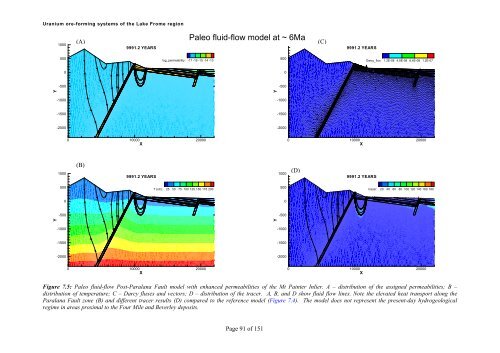Uranium ore-forming systems of the - Geoscience Australia
Uranium ore-forming systems of the - Geoscience Australia
Uranium ore-forming systems of the - Geoscience Australia
You also want an ePaper? Increase the reach of your titles
YUMPU automatically turns print PDFs into web optimized ePapers that Google loves.
<strong>Uranium</strong> <strong>ore</strong>-<strong>forming</strong> <strong>systems</strong> <strong>of</strong> <strong>the</strong> Lake Frome region1000(A)9991.2 YEARSPaleo fluid-flow model at ~ 6Ma1000(C)9991.2 YEARS500log_permeability: -17 -16 -15 -14 -13500Darcy_flux: 1.2E-08 4.8E-08 8.4E-08 1.2E-0700-500-5000 10000 20000X10009991.2 YEARS500tracer: 20 40 60 80 100 120 140 160 1800-500YY-1000-1500-20000 10000 20000X10009991.2 YEARS500T (oC): 25 50 75 100 125 150 175 2000-500YY-1000-1500-2000(B)(D)-1000-1000-1500-1500-2000-20000 10000 20000X0 10000 20000XFigure 7.5: Paleo fluid-flow Post-Paralana Fault model with enhanced permeabilities <strong>of</strong> <strong>the</strong> Mt Painter Inlier. A – distribution <strong>of</strong> <strong>the</strong> assigned permeabilities; B –distribution <strong>of</strong> temperature; C – Darcy fluxes and vectors; D – distribution <strong>of</strong> <strong>the</strong> tracer. A, B, and D show fluid flow lines. Note <strong>the</strong> elevated heat transport along <strong>the</strong>Paralana Fault zone (B) and different tracer results (D) compared to <strong>the</strong> reference model (Figure 7.4). The model does not represent <strong>the</strong> present-day hydrogeologicalregime in areas proximal to <strong>the</strong> Four Mile and Beverley deposits.Page 91 <strong>of</strong> 151
















